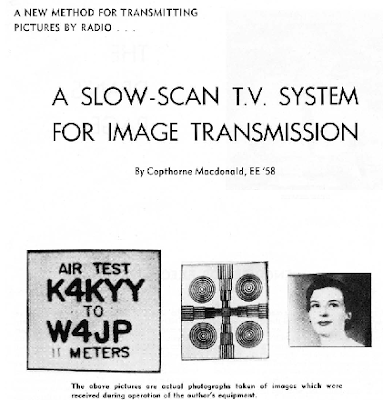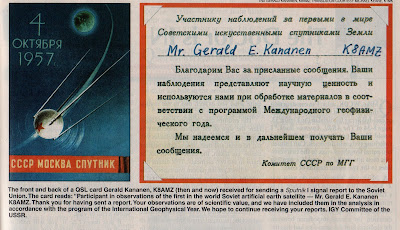 The Early Days of Amateur Radio Slow-Scan TV
The Early Days of Amateur Radio Slow-Scan TV by Copthorne Macdonald
I got my ham license in 1951 at age 15, and like many hams of that era, the bug hit hard. I worked my way through the University of Kentucky's engineering school, taking 5 years to go through, working nights and weekends out at the transmitter of a local 5 kW AM station. Naturally, I was hamming on the way to and from work in my oil-guzzling 1948 Chrysler. The rig was a 15 watt surplus WWII AM rig that took up most of the leg room under the dash.
One day in 1957 I was in the engineering school's library, thumbing through the Bell System Technical Journal, when I came across an article on some Bell Labs signature transmission experiments using ordinary phone lines. For the first time I realized that picture transmission didn't necessarily mean extremely wide bandwidth. And being the ardent ham I was, I instantly wondered if some sort of practical SSTV system could be worked out for ham radio.
I spent my spare time during the next few months looking into the feasibility of the idea. What sort of display tubes were available? (Ans: P7 phosphor.) How did you get frequency response down to DC if ham rig audio response cut off at 300 Hz? (Ans: Modulate an audio subcarrier.) I kept waiting for the fatal flaw to appear, but I saw none. The idea looked feasible.
I took my paper feasibility study to the head of the EE Department, and asked him if I could design and build such a system as part of an independent problem course. (This would give me a few credits as well as legitimize my use of school facilities for the project.) He agreed, and I ordered surplus CRTs and power transformers and such from surplus houses like Fair Radio Sales in Lima, Ohio. During the next 6 months I designed the unit stage by stage, built a "tank" of a flying-spot scanner in the school's machine shop, and put it all together. I still kept waiting for the fatal flaw to appear, but it never did. The system worked!
What is now the Citizen's Band was at that time the 11 meter ham band. All sorts of strange emissions were allowed on 11 meters then, and the first on-air tests were conducted on that band. Since only one set of SSTV equipment existed, audio tape recordings of the SSTV signal were transmitted on the air by one ham station. At the receiving station we listened to this weird sound coming out of the receiver's loudspeaker as we watched the transmitted pictures being painted in light on the screen of the P7 (long-persistence phosphor, radar-type) cathode ray tube.
I wrote a paper describing the system, and entered it in the American Institute of Electrical Engineers (now IEEE) student paper competition in 1958. It won national first prize that year. The ham community first heard about the system in articles that appeared in the August and September 1958 issues of QST magazine.
Shortly thereafter we hams lost the 11 meter band to CB, and had no long-distance HF frequencies on which to use SSTV. I spent the next 10 years working with hams like Don Miller, W9NTP, and Robert Gervenack, W7FEN in specially authorized on-air tests to convince the FCC that slow-scan would cause no problems to regular ham activities and should be permitted in the 75- to 10-meter voice bands as a regular operating activity. In 1968 the FCC finally authorized SSTV operation on a regular basis in the HF bands. In the 1970s my interests shifted to the USES of ham radio -- to "New Directions Radio" -- ham radio for personal growth and social change. Since 1985, I've been spending most of my time writing -- some of it for rent and food money, some on dear-to-my-heart subjects like the development of wisdom, and strategies for living the most effective life possible.
 An e-mail exchange on QRP-L this morning about using ceramic resonators in 455 kHz filter circuits (great idea Grayson!) led me to the ham radio corner of the PAR electronics web site. PAR is the company run by Dale Parfitt, W4OP.
An e-mail exchange on QRP-L this morning about using ceramic resonators in 455 kHz filter circuits (great idea Grayson!) led me to the ham radio corner of the PAR electronics web site. PAR is the company run by Dale Parfitt, W4OP. 






























